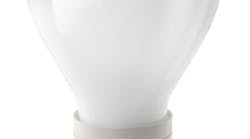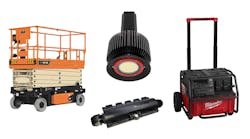Induction lighting is a type of electrodeless lamp, a light source in which the power required to generate light is transferred from the outside of the lamp envelope by means of electromagnetic fields or induction. In other words, induction lamps don’t use electrodes; instead, they use the principle of induction (transmission of energy by way of magnetic field). This contrasts with a traditional electric lamp, which uses electrical connections within the lamp envelope to transfer power. Except for this method of transferring power, induction lighting is similar to conventional fluorescent lamp technology in the way that UV is converted to visible light with the use of phosphors (e.g., mercury vapor in the discharge vessel is electrically excited to produce short-wave ultraviolet light, which then excites the phosphors coating the interior of the lamp to produce visible light), as shown in the Figure (click here to see Figure).
Although they are gaining in popularity, induction lamps have actually been commercially available for the last 20 years. The first type, introduced in the early 1990s, was shaped like an incandescent bulb. Today, there are two main types of magnetic induction lamps — internal and external inductor technology. The original and still widely used form of induction lamps are the internal inductor types. External inductor types, which are a more recent development with a wider range of applications, are available in round-, rectangular-, and olive-shaped versions.
While there are no clear estimates on the size of the induction lighting market in units or dollars — because sales of this product aren’t currently broken out by any regulatory body, such as the National Electrical Manufacturers Association — some manufacturers and installers report growth and opportunity in this area, especially within industrial, high-bay, and exterior area lighting applications.
The benefits
The absence of electrodes in induction technology offers users several benefits:
- Extended lamp life, as the electrodes are usually the limiting factor in lamp life. By not incorporating an electrode, the lamp life is only limited by the life of the electronic components. Most induction lamps sport an impressive lamp life of 60,000 hr to 100,000 hr.
- Improved efficiency levels, with lumen-per-watt efficacies in the 80 to 90 range.
- Reduced costs. Currently estimated at half that of solid-state and metal-halide light sources in specific applications.
- Easy one-for-one lamp and ballast retrofits.
- High quality of light (80 or better), as measured by the color rendering index (CRI).
Other benefits include instant-on capability (enabling use with a photocell or motion sensor), lumen maintenance in excess of 70% of its light output at 100,000 hr, minimal color shifting, and starting temperatures as low as -40°F, supporting their use in extreme temperature conditions.
The drawbacks
To provide a truly fair assessment of these lamp types, however, it’s also useful to know the applications for which induction lighting technology is not best suited. Based on its diffuse nature, induction technology is not ideal for accent lighting (e.g., retail track lighting or otherwise), where the objective would be to create contrast and highlights.
“Induction does well in a wider thermal range (ambient temperatures), but may not have the directional capabilities for certain street lighting applications where the customer requires a more controlled distribution pattern,” says David Alpert, executive major account representative with Sylvania Lighting Services, Danvers, Mass.
In addition, based on its current price range of around $300, induction is not necessarily best suited for projects where first cost is a priority, although it may deliver an attractive payback when considered in the context of its total cost of ownership over its life.
Available options
Some of the most popular induction lamp products currently in the marketplace are those in the 55W to 165W range. The lower-wattage products are popular in area lighting installations, and the higher-wattage products are typically directed toward indoor applications. Products are also available on both sides of this range. The 200W lamps satisfy user needs for high-wattage options in industrial high-bay applications. On the lower end, 40W lamps are popular for their ability to support exterior applications requiring less light output, such as downlighting, canopies, security lighting, etc. Manufacturers are also focusing on ballast development for induction lamps and will be launching ballasts with continuous and bi-level dimming capabilities in the coming months.
Modern applications
A broad range of interior and exterior applications can benefit from induction lighting.
Externally, these include area lighting for municipal streets, parks, campuses, parking garages, and tunnels. Induction lighting has also been very effective as a light source on offshore oil rigs because of its stability, long life, and high resistance to vibration. One of the more high-profile uses of induction lighting technology was near Washington, D.C. within the Pentagon Memorial, unveiled on September 11, 2008, and designed to honor that site’s 9/11 victims (see SIDEBAR: A Fitting and Long Lasting Tribute below).
Interior atria spaces with high ceilings, such as two-story retail spaces and airport concourses, can also benefit from induction lighting, as can other diffuse/general lighting applications, such as industrial low-bay/high-bay settings, exterior signage installations based on the -40°F starting temperature (large box signage especially), covered parking facilities, decorative post-top street lights, and exterior-mounted security lights. Other successful interior installations have occurred in gyms, indoor sports fields, and indoor equestrian facilities. In addition, the technology is well-suited to cold storage applications like walk-in freezers and unconditioned warehouses, where induction lighting can be combined with occupancy sensors for maximum efficiency.
Overall, induction technology is ideal in any application where long life is critical and/or where maintenance cost avoidance is a priority, such as in difficult-to-reach applications like high ceilings where lift trucks are required or hazardous locations, such as bridges and tunnels.
Tips for contractors
Although this technology is not as old as some others, induction lighting is mature and proven, delivering attractive white light, high lumen maintenance, significant energy savings, and long life to a variety of indoor and outdoor applications. So how do you put this technology to work for you and capture some new business in the process? Here are several tips for electrical contractors to consider:
- Because induction lighting carries a relatively higher initial cost than some other light sources, you must sell induction lighting on the basis of the total cost of ownership over the life of the technology, stressing its energy efficiency and long life.
- Thermal management of an induction system (with the electronics) is critical for the life of the system, and its life can be significantly impacted by the degree of control exerted over the temperature of the electronic components. Although the system is intended to last for years, improper design of an induction luminaire will negatively impact its lifespan. “Temperature and fixture venting definitely play a big part in how well any of these products will perform and last over time,” says Alpert.
- Stick with reputable induction lighting products and brands. “There are numerous off-shore solutions vying for the business,” says Alpert. “Beware of companies that are making 100,000-hr claims with 90+% lumen maintenance on their induction lamps, as testing has revealed that many offshore products have poor lumen maintenance due to their manufacturing process.”
- Proper installation is critical. “Our contractors install both new fixtures that use induction components as well as retrofit kits that will work in many existing fixtures,” says Alpert. “Whether a new fixture or a retrofit is involved, it’s important to understand that the efficiency of the fixture is predicated on good optics. Retrofit kits should include a new reflector to properly illuminate the area.”
Bloom, a freelancer and consultant, is an 18-year veteran of the lighting and electrical products industry. She can be reached at [email protected].
A Fitting and Long-Lasting Tribute
In commemoration of the 184 people who died at the Pentagon in the terrorist hijacking of American Airlines Flight 77 on September 11, 2001, a memorial with a unique and memorable lighting design was unveiled just southwest of the Pentagon in Arlington County, Va., during a special ceremony in 2008. The design of the Pentagon Memorial features 184 units of bench-like cantilevered steel suspended over illuminated water pools; each unit is driven by a 55W induction lamp projecting white light into each reflecting pool.
Chris Hartzler of Balfour Beatty Construction, the general contractor on the project, explained in a previously published interview that the memorial was the primary light source for the 1.95-acre memorial park. “A key challenge was to mount the light horizontally, underground, have it reflect through water, and still emit enough light so that visitors could safely navigate their way through the park at night,” says Hartzler.
Because the memorial is open to visitors 24 hr a day year-round, it was critical for the team to select a lamp that not only delivered bright, white light, but could also promise reliable, long life. Induction lighting proved to be an ideal choice of technology for the application.
Today, luminaire replacements can be easily managed by the park’s maintenance crew. The memorial continues to stand as a timeless tribute to the brave victims of the tragedy on 9/11. “In my opinion, the best time to view the park is at dusk when all the lights come on,” says Hartzler. “The place is literally transformed.”




